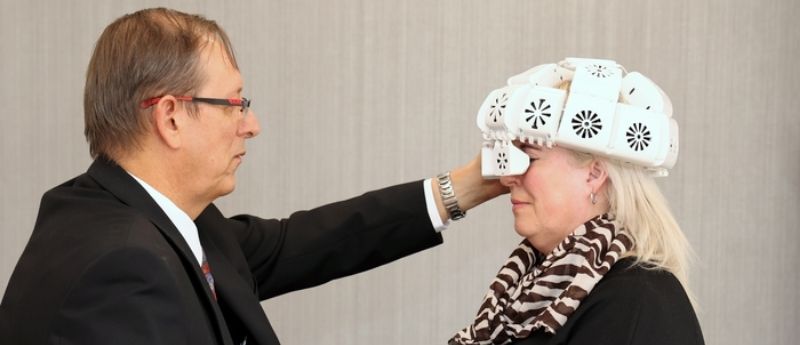Infrared therapy: casting dementia treatment in a new light

Infrared light therapy could alleviate symptoms in dementia patients, according to a pilot study.
Researchers have found that transcranial photobiomodulation therapy (PBM-T) – where the individual wears a helmet that delivers infrared light to the brain –improved memory, motor function and processing skills in individuals with normal intellectual function. They suggest that PBM-T may also have a positive effect on individuals with dementia.
Paul Chazot (Durham University, UK), co-lead of the study, has spent the last 20 years pinpointing and validating a specific wavelength of infrared light that can be utilized in dementia therapy. Through previous studies, he demonstrated that PBM-T with a specific wavelength improved memory performance and reduced beta-amyloid in an Alzheimer’s mouse model.
Gordon Dougal (Maculume Ltd, Durham, UK), also co-lead, devised the PBM-T helmet, which works by delivering infrared light at a wavelength of between 1060 and 1080 nanometres, from 14 fan-cooled LED light arrays deep into the brain. During each 6 minute treatment cycle, 1368 J of energy is delivered to the cranium.
 How smells can linger in your memory
How smells can linger in your memory
Scents are not only processed by the olfactory center, but also by the brain’s reward and aversion systems, explaining how scents can take on meaning.
Read now>>>
In the current study, 14 healthy individuals from the UK aged 45 years and over, received PBM-T for 6 minutes twice a day over a period of 4 weeks. Infrared light at a wavelength of 1068 nanometres was administered to the participants. Thirteen control participants used a dummy PBM-T helmet.
Participants in both groups underwent a series of tests to assess their memory, verbal, and motor skills, before and after the treatment period. Those receiving PBM-T significantly improved their performance in motor function (finger tapping), memory performance (mathematical processing, a type of working memory), delayed memory and brain processing speed, compared to those in the control group. In addition, no adverse effects were reported.
The researchers believe that the helmet operates by stimulating mitochondria, leading to a rise in ATP and providing more energy for cellular processes and nerve cell repair. What’s more, they say the therapy can increase levels of nitric oxide, increasing blood flow and delivering more oxygen to white matter deep in the brain.
Whilst the latest findings are promising, the team acknowledge that more research into the use and effectiveness of the therapy is needed.
“Current clinical practice can only set the stage for optimal recovery with little or no effect upon cellular function. Laboratory work exploring the mechanism of action of PBM-T1068, indicates this therapeutic tool may well help dying brain cells regenerate into functioning units once again. Much more research is needed to fully understand the mechanism of action,” explained Dougal.
Patients can self-deliver PBM-T in the comfort of their own home, and each helmet costs approximately £7250 to buy. The team believes PBM-T could also help individuals with other disorders, such as Parkinson’s, traumatic brain injury or motor neuron disease.
PBM-T – also known as Transcranial near-infrared treatment – has been found to have similar benefits in separate Alzheimer’s clinical studies involving Chazot and Dougal. One of these studies, led by Jason Huang (Texas A&M University, TX, USA), discovered that the therapy had a positive effect on both men and women with mild to moderate dementia.
“…we and our US research collaborators recently also published a new independent clinical study which provides the first evidence for profound and rapid improvement in memory performance in dementia… This could provide a novel disease-modifying strategy for dementia, with the potential to alleviate many of the serious problems faced by people with dementia and reduce the burden on their caregivers,” concluded Chazot.